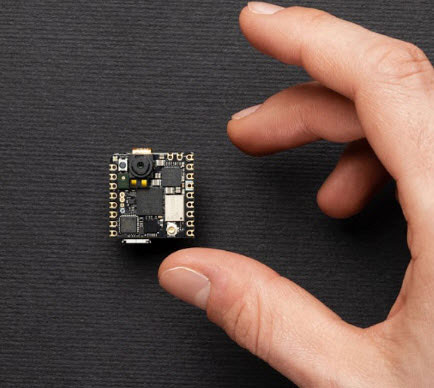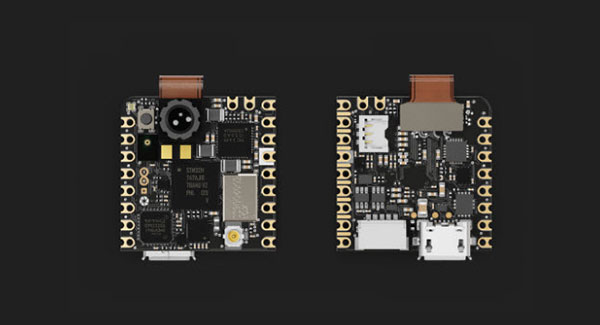制造商零件编号 ABX00051
NICLA VISION
Arduino
The diverse range of Arduino boards is already well-equipped for various electronics projects, ranging from beginner-level to more elaborate DIY projects and commercial products (such as desktop 3D printers). For their professional users, Arduino offers the Portenta range of devices that come with industrial-grade specifications and features, such as real-time capabilities and out-of-the-box compatibility with the Arduino IoT Cloud. The Nicla family of boards is the newest addition to the ever-growing family of Arduino devices.
This article focuses on the main features and specifications of the Arduino Nicla Vision, a compact industrial-grade board that has the potential to drive professional machine-vision applications.
 The Nicla range of development boards offers the smallest footprint in the Arduino ecosystem. https://blog.arduino.cc/2022/03/08/meet-the-nicla-vision-love-at-first-sight/
The Nicla range of development boards offers the smallest footprint in the Arduino ecosystem. https://blog.arduino.cc/2022/03/08/meet-the-nicla-vision-love-at-first-sight/
The Arduino Nicla Vision is qualified for a wide range of applications. However, as the name implies, it’s mainly intended to be incorporated into machine-vision-based applications. For that purpose, the feature-rich device includes an onboard color camera with a resolution of two megapixels. In addition, it offers the processing power for making sense of the images picked up by the camera. For that purpose, the device contains a powerful yet energy-efficient STM32H747-based dual ARM® Cortex® processor. This SoC combines two independent processors, namely an M7 core that can run up to 480 MHz and an additional M4 core clocked at up to 240 MHz. It further contains one Megabyte of RAM and two Megabytes of flash memory with an additional 16MB of QSPI flash. These features make the small Nicla Vision the perfect choice for numerous applications such as QR code tracking, facial recognition, AI, gesture recognition in smart kiosks, and predictive maintenance.
The square shaped Nicla boards have a side length of just under one inch. The small footprint allows engineers to integrate the Nicla boards into new designs and existing prototypes and devices.
A few onboard sensors complement the 2MP color camera of the Nicla Vision. The device contains accurate professional-grade sensors for measuring distance, sound, movement, and vibrations in the form of a 6-axis motion sensor (LSM6DSOXTR), an integrated omnidirectional MEMS microphone (MP34DT06JTR), and a distance sensor.
 This product render shows both sides of the new Arduino Nicla Vision. Image source: https://www.arduino.cc/pro/hardware/product/nicla-vision
This product render shows both sides of the new Arduino Nicla Vision. Image source: https://www.arduino.cc/pro/hardware/product/nicla-vision
The newly introduced Nicla form-factor also exposes 19 usable general-purpose I/O pins, of which ten are digital I/O pins, and two are analog inputs. The Nicla family of boards allows engineers to use up to twelve independent external interrupts. In addition to the GPIO pins, the small Nicla Vision also includes a Bluetooth LE module and Wi-Fi capabilities. An additional NXP SE050C2 crypto chip helps keep sensitive user data secure when uploading data to the cloud. Lastly, a JST 3-pin connector allows the Nicla Vision to run off a standard single-cell 3.7V Li-Ion or Li-Po battery.
The new Nicla-range of Arduino boards fits perfectly into the existing Arduino ecosystem. The new devices are fully compatible with existing libraries and Arduino Pro devices, such as the Portenta range of components. Software-wise, the Nicla Vision supports MicroPython and also fully integrates with OpenMV to allow engineers to quickly implement machine-vision prototypes and wireless edge nodes for all kinds of applications.
However, engineers and advanced hobbyists can also use the familiar Arduino IDE and Arduino Cloud tools for programming the Nicla vision. These tools also include the Arduino IoT cloud and its OTA update functionalities. In addition, users can also add custom support for using other third-party cloud services.
The new Nicla-family of Arduino devices includes two square-shaped boards that will likely see plenty of use in DIY and professional edge applications. The Nicla Vision’s 2MP color camera sensor and other built-in devices for collecting various environmental data make it a suitable candidate for machine-vision-based applications at the edge.
The Nicla Vision also includes various state-of-the-art connectivity options such as BLE and Wi-Fi, which allow the device to upload collected data to the cloud. An additional external secure element provides data security and integrity. The Nicla-range of devices is compatible with the existing Arduino ecosystem and the Arduino Cloud tools. Programmers can also add support for third-party APIs and cloud services.